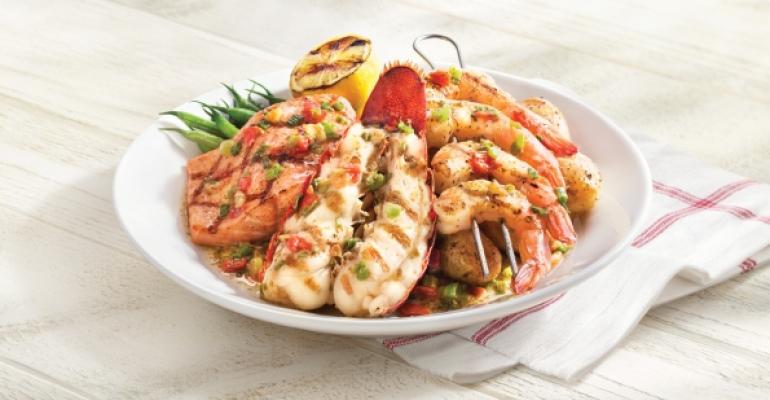Red Lobster is going back to what made it popular in the first place – lobster -- in a bid to reinvigorate its brand. The move, its first major change since Darden sold the brand to the private equity group Golden Gate Capital for $2.1 billion in July, is supported by a national TV ad campaign created by its agency Publicis Kaplan Thaler.
“We want first and foremost to stand for great seafood,” said Salli Setta, president of Red Lobster. “We have to make sure we have the right seafood dishes, and we have to make sure that we execute them well.”
With the changes, 85 percent of Red Lobster’s new menu will be seafood based, up from 75 percent beforehand. The menu eliminates less popular items, many of which feature land-based proteins such as pork.

“We wanted to return to what historically has been successful for us, and that’s 85 percent,” Setta said. “Lobster isn’t our middle name, it is our name.”
The menu also uses more trendy flavors and a variety of presentations as well. It includes new Wood-Grilled Lobster Tacos with three flour tortillas, stuffed with lobster, cilantro slaw, house-made pico de gallo and jalapeno ranch, served with wild rice pilaf. That item is on the low end of the price range at $12.99.
Other items include Lobster Scampi Linguini, with six ounces of lobster over a bed of linguini in a white wine and garlic scampi sauce, and the Roasted Maine Lobster Bake, with three petite Maine lobster tails, split and roasted with sweet corn on the cob and baby gold potatoes.
On the high end of the price range is the new Wood-Grilled Lobster, Shrimp and Salmon with lobster tail, a jumbo shrimp skewer and Atlantic salmon, wood-grilled and finished with brown butter and served over green beans and baby gold potatoes.
The company also added new Crispy Shrimp Lettuce Wraps, and it added more shrimp to its Ultimate Feast, which now includes lobster, snow crab legs, garlic shrimp scampi, and Walt’s Favorite Shrimp with rice pilaf and a side dish.

“Guests were telling us the Ultimate Feast wasn’t as ultimate as it could be,” said Danielle Connor, senior vice president of menu strategy and culinary development for Red Lobster.
“There’s lobster on every page of the menu,” Connor added. “We’re bringing lobster to every occasion and price point.”
The physical menu has been redesigned as well. Before, Red Lobster customers were given a wordy, five-part menu at the table. The new menu has two parts, with specials and today’s fresh fish featured on the front, followed by drinks, appetizers, entrees, desserts and special sections, such as their selections of items with fewer than 600 calories.

The menu contains more photos to illustrate the selections, which Connor said help with both old and new items. That helps guests “understand the total variety of the menu,” she said.
By reducing the number of non-seafood items and increasing lobster and seafood items, the company hopes to improve its brand reputation without completely abandoning the so-called veto vote. That comes from customers who might convince groups to go to another chain because they don’t like seafood.
Seafood consumption trends
(Continued from page 1)
There’s no right formula for a specialty chain to balance its brand promise with its ability to cater to skeptical consumers, said Dennis Lombardi, foodservices strategist for consulting firm W.D. Partners. He generally said brands like Red Lobster should have about 20 percent non-specialty items to cater to that group.
“That’s a good place to start,” Lombardi said. “If you start getting 40 percent non-specialty items, people are going to wonder what’s going on.”
But seafood concepts might have a higher percentage of veto votes than other concepts, some analysts believe, because overall seafood consumption has trended down.
From 2004 to 2013, for instance, annual per capita seafood consumption in the U.S. declined from 16.6 pounds to 14.5 pounds, according to the National Fisheries Institute. By contrast, Americans eat about 110 pounds of red meat a year.
“With seafood, you have to be very concerned about the veto vote,” Gordon said.
That said, he noted, it’s difficult for Red Lobster to avoid concerns over seafood, given that it’s in its name.
Setta noted that seafood consumption actually increased slightly last year. She also believes that much of the decline in annual consumption is on seafood prepared in the home and added that people are still more likely to get a good lobster meal at a restaurant.
“I consider myself a decent cook,” Setta said. “But I’m not going to make wood-grilled lobster, shrimp and salmon, topped with brown butter at home.”
Contact Jonathan Maze at [email protected].
Follow him on Twitter at @jonathanmaze

